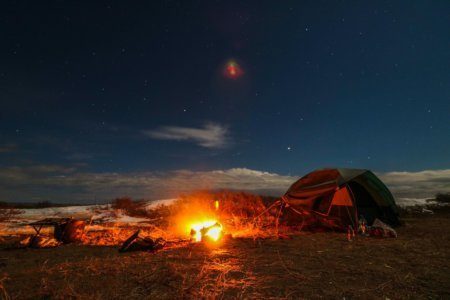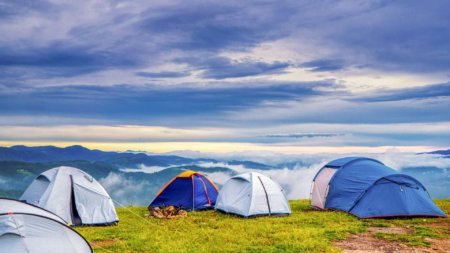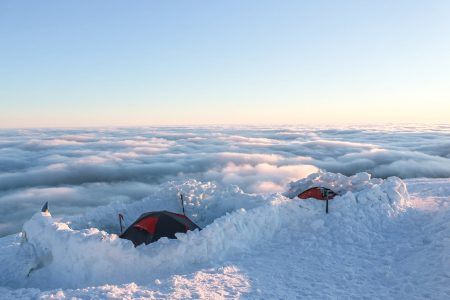How to Live in a Tent
Have you ever wondered how to live in a tent? If you follow these tips and tricks, you’ll be able to make living in a tent a little more bearable.
How do you live in a tent? Follow these steps to safely live in a tent:
- Choose your location wisely.
- Set-up near a water supply.
- Be aware of local wildlife.
- Figure out food sustainability.
- Stay as clean as possible.
- Prepare properly for cold weather.
Whether or not you think that living in a tent long-term is a great opportunity to get in touch with nature or a punishment that deprives you of your precious Starbucks, living in a tent takes a few things to make it work well.
[wc_toggle title=“Table of Contents” padding=“” border_width=“” class=“” layout=“box”]
[/wc_toggle]

Living in a Tent
These tips are more aimed at someone who will be living in a tent for the long term, but they’ll still be helpful even if you’re just going camping for the weekend.
If you’re going to try to live in a tent over the long haul, you’re going to want to keep the following tips and tricks in mind.
Choose the Best Location
There’s just no escaping “the first rule of real estate,” is there? Always choose your location wisely.
What is the surrounding area like? Is it stable and, just as importantly, is it safe? A tent doesn’t afford much in the way of home security so you’re going to want to make sure that you’re staying in an area that is safe.
You’ll also want to consider a variety of other factors that might impact the overall degree of comfort you experience during your stay.
[wc_box color=“primary” text_align=“left” margin_top=“” margin_bottom=“” class=“”]
Is a tent safe during lightning? Check out this article to find out.
[/wc_box]
You’ll want to pay close attention to the soil quality of the area where you’re staying. If the surface is rocky or asphalt-hard, that’s going to make for an uncomfortable night’s sleep. If the surface is too moist or muddy, on the other hand, you’ll have the opposite problem.
On the flip side, finding an area with a nice big tree can give you a double bonus of added shade and shelter, while staying by a lake gives you access to water that you can use for bathing and, if you can filter it properly, drinking as well.
Water is Key to Your Survival
Setting up near a good source of water is probably the most important part of living in a tent. Other than shelter (which you already have with your tent) the first thing to kill you in a survival situation will be lack of water.
Ideally, you’d be close enough to a source of water so you don’t need to walk for miles every day to get more water, but far enough away that you won’t need to worry about animals stumbling across you because they’re attracted to the water source.
Larger bodies of water, like ponds and lakes, potentially offer a good fishing spot on top of being a water supply, but they will probably need more filtration than water from a small, flowing stream.
Moving water, like streams, brooks, and rivers are usually better sources of water than standing water.

Be Aware of Animals
You’ll also want to be aware of any and all animals that may populate the area where you’re staying. While you may be a bona fide animal lover, the fact of the matter remains that not every animal will love being around you, especially if they are wild animals.
A few animal awareness tips:
● Make sure that you remember to zip up your tent at the end of the night so as not to wake up to a “surprise guest” in the middle of the night
● Don’t leave food or other items that might attract animals
● Take special caution if you are staying anywhere with bears
● While bugs probably aren’t unavoidable, you’ll want to try to avoid pitching your tent near ant colonies, beehives, wasps’ nests, and similar problematic areas

Figure Out Food Sustainability
Something you’ll want to figure out far in advance is what and how you’re going to eat. Even if you plan to “live off the land,” that’s going to take a great deal of preparation.
For one thing, you’ll need to make sure that you are staying somewhere that facilitates “living off the land” – camping outside a Walmart won’t do. You’re going to need to make sure that any and all food you scrounge up are actually safe to eat, and that you clean and, if necessary, thoroughly cook them.
You’ll also want to make sure that your food source is sustainable. If you have to choose a place that has a limited food source, make sure it’ll last longer than a day or two.
It’s not the end of the world since you’re living in a tent, but it takes a lot of energy to pack up and move so choosing the right place to set up camp the first time will save you a headache.

Proper Sanitation
Even if you are the most rugged outdoors person around, you need to make sure to maintain good sanitation standards while living in your tent. Having poor sanitation standards is a fast track to contracting a disease or suffering other medical problems.
Water is key to keeping yourself clean and healthy. It doesn’t have to be so clean that you can drink it, but it needs to be clean enough so you can keep your body clean. For hand washing, I always suggest using drinking water if you can.
You’ll also want to be sure to “answer the call of nature” far away from your tent, your food and water supplies, for obvious reasons.
How Cold is Too Cold to Sleep in a Tent
There’s a very distinct difference between being comfortable and surviving. People sleep in tents in the extreme cold all the time, but they also use special equipment and even then, they’re not comfortable.
Temperatures between 50 and 60 are about as cold as you can get and still be comfortable in a tent with just a cheap sleeping bag. When you get colder than that you’re going to wish you had something better, even if you’ll make it through without any risk of injury.
Temperatures in the 40s down to the 30s are going to be miserable if you just have a sleeping bag and don’t take any additional measures to keep yourself warm. If you get down below the low 30s you run the risk of suffering frostbite or hypothermia.

How can you insulate a tent?
Insulating a tent is one of the best ways to keep it warm when the temperature drops. It’s usually passive (although heating an insulated tent is much more effective as well) so once it’s set up, you’re good to go.
Start by using the smallest tent that meets your needs. A smaller tent means less space to heat and makes every other step that you take to keep your tent warm all that more effective!
The best form of insulation when you’re camping is an air mattress. A foam sleeping pad can work also but I always find that they’re still quite a bit colder than an air mattress. Keeping your sleeping bag from contacting the bottom of your tent prevents the exchange of heat between your body and the ground.
A windbreak is another great way to insulate your tent from the weather outside. Just hang a line between two trees, attach a tarp to the line and secure the tarp to the trees or directly to the ground. This will keep wind and blowing snow and rain from directly hitting your tent.
Cover the floor of your tent with blankets to help insulate the inside of the tent from the cold ground. Wool blankets are the best because they continue to keep most of their insulating properties even if they get wet, but any kind of blanket will work.
Spread dead leaves and pine needles on the ground under your tent before you set it up. This will act as another layer of insulation for the floor of the tent. to keep it pretty uniform and flat so it’s still comfortable when you’re sleeping.
You can insulate the walls of your tent from the inside and the outside. Pile leaves against the outside of your tent to act as insulation from the outside. Ideally, you’d have a tent with a liner already, but you can also make one by suspending blankets from the walls and ceiling. You can also use emergency blankets to line the inside of the tent. They help reflect some of the heat back and prevent it from escaping through the walls.
Another great way to stay warm is to keep yourself insulated. Dress in layers before you go to sleep. They will trap your body heat and keep you warm in your sleeping bag.
Keep all of your wet items outside of the tent. As the water evaporates from your wet items, it will transfer that moisture to the air in the tent. That moisture will then cause condensation and get other things wet. You want everything as dry as possible inside your tent.
To recap, do these things to insulate your tent in the winter:
- Use the smallest tent you can
- Sleep on an air mattress
- Make a windbreak outside
- Cover the floor with blankets
- Spread leaves or pine needles under your tent
- Cover the outside of your tent with leaves
- Hang blankets or tape up emergency blankets inside
- Dress in layers before you go to sleep
- Keep all of your wet items outside
Can I use a 3 season tent in winter?
You can use a three-season tent in the winter if you make sure that you insulate it well and get a heater once it gets really cold out. It isn’t the ideal situation but it’s certainly possible.

Using a Heater in a Tent
Heating a tent with a heater is always an option and once it gets really cold, it’s going to be required. There comes a point when there just isn’t enough insulation in the world to keep you warm without some kind of outside help.
What kind of heater is safe to use in a tent?
Electric heaters are probably the safest option if you happen to have access to electricity. There’s still the danger of them starting a fire, but they don’t make carbon monoxide so they’re safe from that standpoint.
There are other types of heaters that you can use inside a tent as well. They’re normally marked as safe to use indoors or indoor safe.
Even indoor safe heaters still have some precautions to take. Don’t sleep with the heater on, make sure it has a small opening near it to allow oxygen in and try to keep flammable materials as far away from them as you can.
Look for heaters that turn off if they get knocked over and have an oxygen sensor that turns them off if the oxygen level gets too low.
Can you use a kerosene heater in a tent?
I don’t recommend using a kerosene heater in a tent. It’s possible but they do produce carbon monoxide and consume oxygen, both of which are deadly in small enclosed spaces.
Of all the possible heater types, kerosene is the pone that I would specifically recommend you avoid. Even if it’s marked as safe for indoor use!
Can you put a propane heater in a tent?
Propane heaters designed for tents are what is known as catalytic heaters. They don’t produce a flame or carbon monoxide so they’re much safer to use in a tent than other types of heaters.
Indoor propane heaters like this Mr. Buddy Heater are great.
Can you use a butane heater in a tent?
There are butane heaters out there that can be used in tents, but they aren’t as common as propane heaters. Most of the commonly available butane heaters are designed for outdoor use and put out a ton of heat really fast. They’re not ideal for heating inside.
Can you cook inside your tent?
You shouldn’t cook inside your tent. Open flames inside a tent are a bad idea and they can consume a dangerous amount of oxygen.
Boiling water and cooking food in a tent also introduces humidity which will lead to condensation on the inside of your tent which is annoying in the summer and potentially harmful in the winter.
Conclusion
Living in a tent is certainly possible, and if you follow these tips it’s definitely going to be a little easier for you. The worst time of year to be in a tent has got to be in the winter when it’s cold outside, but if you a couple of steps to insulate your tent and get a heater, you’re going to do just fine!
The previous article How to Live in a Tent – Tips and Tricks to Make it Bearable was first published to: www.readylifestyle-staging.gtgrgq9c-liquidwebsites.com
How to Live in a Tent – Tips and Tricks to Make it Bearable published first on https://readylifesytle.tumblr.com
Comments
Post a Comment